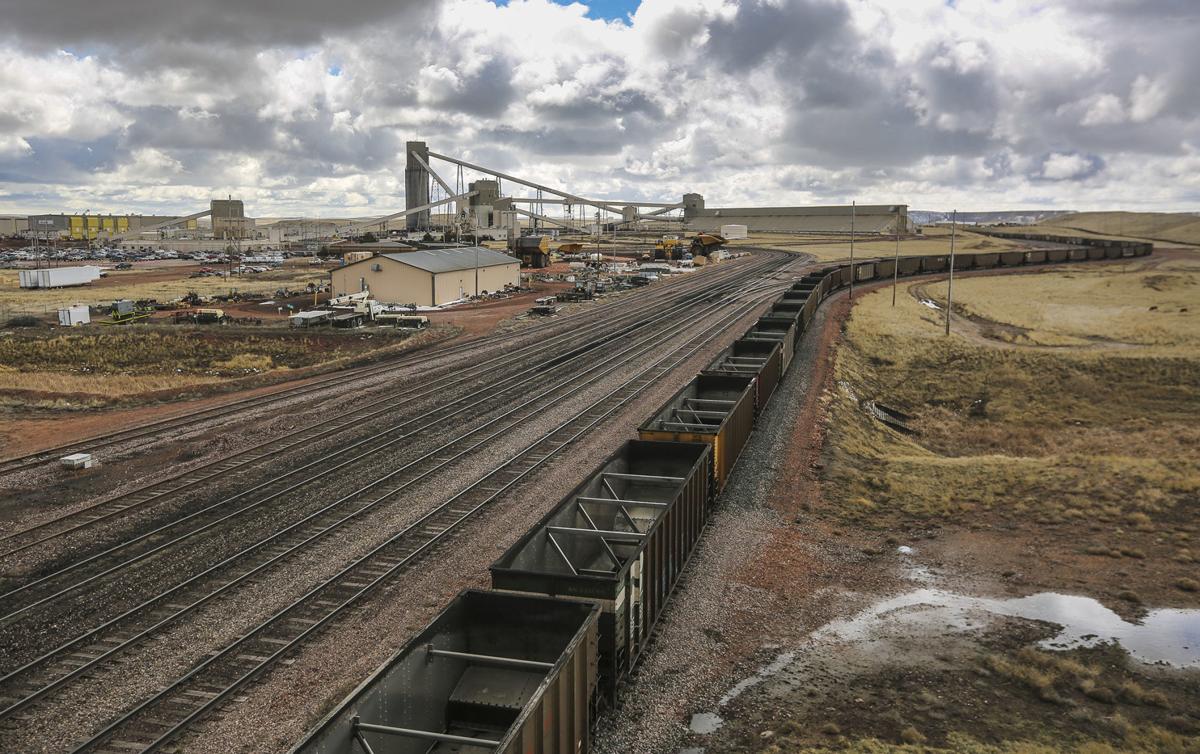Japan Presents Opportunity for Powder River Basin Coal

By Jonathan Gallardo
October 23, 2018 - Japanese power companies are looking for cleaner sources of coal and the Powder River Basin can fill that need.
But Wyoming needs to continue researching and developing technology if it’s going to become the most attractive option.
That was the message to local and UW officials in Gillette this past week by CoalinQ, a Japanese consulting firm hired by the University of Wyoming School of Energy Resources to study the Japanese coal market.

A train approaches Black Thunder coal mine outside Wright on March 29.
Photo by Josh Galemore, Star-Tribune
It’s just another way the Cowboy State is working with the island nation. The Japan Coal Energy Center, or JCoal, signed an agreement with Wyoming in 2016, beginning a partnership to discuss coal trading, economic development and carbon technology, among other things.
Kawasaki Heavy Industries also has committed to study carbon capture technologies at the Integrated Test Center.
Coal, nuclear power and natural gas each make up close to a third of Japan’s energy portfolio. Australia is the largest supplier of coal to Japan, with 66 percent. The U.S. supplies 0.9 percent of Japan’s coal, which is coming from Montana and Utah.
Similar to how coal has a negative public perception in the United States, nuclear power is the black sheep of the Japanese energy market.
“We don’t trust power companies when it comes to nuclear energy,” said Etienne Boisnier, director of CoalinQ. “Nobody wants to invest in nuclear in Japan, especially insurance companies and banks.”
The Japanese government is projecting coal’s share of the energy picture to decrease by 2030, but those in the energy industry think the opposite. In 12 years, all of Japan’s nuclear power plants will have to be retired because they’ll have reached their age limits, Boisnier said.
Meanwhile, there are more than 30 new coal plants in the pipeline, and coal imports are expected to grow to supply them.
“If you say, ‘I need a power plant here,’ nobody really complains about it, except if it’s nuclear (power),” Boisnier said, adding that a coal power plant can be built, permitting included, from the ground up in two years.
There is a desire to decrease the country’s reliance on Australian coal in favor of a cleaner fuel, Boisnier said, and that’s where the Powder River Basin can take advantage, but only if it can figure out how to upgrade its coal.
The PRB is facing stiff competition from Indonesian coal, which like local coal is low in sulfur, but Indonesian coal also has a much lower ash content.
In Wyoming, the coal ash that is produced by coal-fired power plants is stored in pits. But Japan doesn’t have room to store that ash, so it’s spending a lot of money to ship it elsewhere.
If researchers can figure out how to decrease the ash content in Powder River Basin coal, that would make it more attractive to Japanese power companies, Boisnier said.
“It’s something we haven’t looked at,” said Richard Horner, director of Emerging Projects and Technology at the University of Wyoming School of Energy Resources.
Campbell County Commissioner Rusty Bell said now is an exciting time for northeast Wyoming with all the research on not only in carbon technology, but upgrading coal.
He said a lot has changed in the four years since he was elected to the commission. Then, Wyoming was worried about the regulations the Obama administration had placed on fossil fuels. Doing business with Japan wasn’t on anybody’s radar.
“We weren’t thinking about technology,” he said. “But it’s come full circle now. The world needs our technology and our coal.”
The transportation issue still has to be figured out, but both Horner and Bell said upgrading coal to make it cleaner could help solve that problem as well.
As far as renewable energy in Japan, it does not pose a threat to coal. Horner said it will “always be a niche,” but a necessary one. Boisnier said the most optimistic projections have it making up 5 percent of the market.
Five years ago, the government was pushing for utility companies to accept renewable energy. Now, with nuclear energy coming back, “a lot of renewable energy projects are going bankrupt,” Boisnier said.
Renewables also are facing opposition from the fishing industry, which doesn’t want its waters filled with turbines.
Horner said other Asian countries such as South Korea and India are growth markets for coal, but more research needs to be done on those markets to find out what makes them tick.
“There’s no reason coal shouldn’t be providing electricity to 2.5 billion people,” Bell said. Half of those people have no access to energy, and the other half don’t have reliable energy. “If it’s really about global climate change, we should be promoting low-sulfur coal.”
While all this research is going on, what Campbell County can do is continue to tell its story.
Bell said he wants to bring people “from the other side of the political spectrum” to Gillette so they can see “what we do,” because the “biggest thing to come out this is relationships.”
Whether it’s doing business with Japanese power companies or talking with politicians in Washington to open up a port, Bell said those relationships will be vital for the future of the Powder River Basin.

